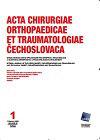Antimicrobial Activity of the Most Common Antibiotic-Releasing Systems Employed in Current Orthopedic Surgery: in vitro Study.
IF 0.4
4区 医学
Q4 ORTHOPEDICS
Acta chirurgiae orthopaedicae et traumatologiae Cechoslovaca
Pub Date : 2023-06-22
DOI:10.55095/achot2023/027
引用次数: 0
Abstract
PURPOSE OF THE STUDY Infections of joint replacements represent one of the most serious problems in contemporary orthopedics. The joint infections treatment is usually multimodal and involves various combinations of drug delivery and surgical procedures. The aim of this study was to evaluate and compare the bacteriostatic and bactericidal properties of the most common antibiotic carriers used in orthopedic surgery: bone cements mixed with antibiotic and porous calcium sulfate mixed with antibiotic. MATERIAL AND METHODS Three commercial bone cements (Palacos®, Palacos® R+G, Vancogenx®) and commercial porous sulfate (Stimulan®) were prepared with a known concentration of vancomycin (a glycopeptide antibiotic). Specifically, for the purpose of our study, the testing specimens were prepared to release 0, 1, 2, 4, 8, 16, 32, 64, 128, 256, and 512 mg of vancomycin into 1 liter of solution. The specimens with increasing amount of antibiotic were placed in a separate tubes containing 5 mL of Mueller-Hinton broth inoculated with a suspension (0.1 m, McFarland 1) of the reference strain CCM 4223 Staphylococcus aureus to evaluate their bacteriostatic properties (broth dilution method). After this initial incubation and evaluation of the broth dilution method, an inoculum from each tube was transferred onto blood agar plates. After another 24-hour incubation under the same conditions, we evaluated the bactericidal properties (agar plate method). As many as 132 of independent experiments were performed (4 specimens × 11 concentrations × 3 repetitions = 132). RESULTS The bacteriostatic properties of all investigated samples were excellent, perhaps with the exception of the first bone cement (Palacos®). The sample Palacos® started to exhibit bacteriostatic properties at concentrations ≥ 8 mg/mL, while all other samples (Palacos R+G®, Vancogenx®, and Stimulan®) were bacteriostatic in the whole concentration range starting from 1 mg/mL. The bacteriocidic properties did not show such clear trends, but correlated quite well with different properties of the investigated samples during mixing - the most homogeneous samples seemed to exhibit the best and the most reproducible results. DISCUSSION The reliable and reproducible comparison of ATB carriers is a difficult task. The situation is complicated by high numbers of local antibiotic carriers on the market, numerous antibiotics used, and differences in clinical trials at different laboratories. Simple in vitro testing of bacteriostatic and bacteriocidic properties represents a simple and efficient approach to the problem. CONCLUSIONS The study confirmed that the two most common commercial systems used in the orthopedic surgery (bone cements and porous calcium sulfate) prevent bacterial growth (bacteriostatic effect), but they may not be 100% efficient in complete elimination of bacteria (bacteriocidic effect). The scattered results in the case of bacteriocidic tests seemed to be connected with the homogeneity of ATB dispersion in the systems and with the lower reproducibility of the employed agar plate method. Key words: local release of antibiotics; bone cements; calcium sulfate; antimicrobial susceptibility.目前骨科手术中使用的最常见抗生素释放系统的抗菌活性:体外研究。
关节置换术感染是当代骨科最严重的问题之一。关节感染的治疗通常是多模式的,包括药物输送和外科手术的各种组合。本研究的目的是评估和比较骨科手术中最常用的抗生素载体:混合抗生素的骨水泥和混合抗生素的多孔硫酸钙的抑菌和杀菌性能。材料和方法用已知浓度的万古霉素(一种糖肽抗生素)制备三种商用骨水泥(Palacos®,Palacos®R+G, Vancogenx®)和商用多孔硫酸盐(刺激an®)。具体来说,为了我们的研究目的,准备测试标本,将0、1、2、4、8、16、32、64、128、256和512 mg万古霉素释放到1升溶液中。将抗生素添加量增加的标本置于单独的管中,管中含有5ml接种参考菌株CCM 4223金黄色葡萄球菌悬浮液(0.1 m, McFarland 1)的muller - hinton肉汤,以评估其抑菌性能(肉汤稀释法)。在初始孵育和肉汤稀释法评估后,将每根试管中的接种物转移到血琼脂板上。在相同条件下再孵育24小时后,我们评估了杀菌性能(琼脂平板法)。独立实验共132次(4个标本× 11个浓度× 3次重复= 132次)。结果除了第一骨水泥(Palacos®)外,所有样品的抑菌性能都很好。样品Palacos®在浓度≥8mg /mL时开始表现出抑菌性能,而所有其他样品(Palacos R+G®,Vancogenx®和Stimulan®)在从1mg /mL开始的整个浓度范围内都具有抑菌作用。在混合过程中,其杀菌性能并没有明显的趋势,但与所研究样品的不同性能有很好的相关性——最均匀的样品似乎表现出最好的和最可重复的结果。ATB携带者的可靠和可重复性比较是一项困难的任务。由于市场上大量的当地抗生素携带者,使用的抗生素种类繁多,以及不同实验室临床试验的差异,情况变得更加复杂。简单的体外抑菌和杀菌性能测试是解决这一问题的一种简单而有效的方法。结论:本研究证实骨科手术中最常用的两种商用系统(骨水泥和多孔硫酸钙)可以防止细菌生长(抑菌作用),但它们可能不是100%有效地完全消除细菌(杀菌作用)。在杀菌剂试验的情况下,分散的结果似乎与系统中ATB分散的均匀性以及所采用的琼脂平板法的低重复性有关。关键词:抗生素局部释放;骨水泥;硫酸钙;抗菌药物的敏感性。
本文章由计算机程序翻译,如有差异,请以英文原文为准。
求助全文
约1分钟内获得全文
求助全文
来源期刊
CiteScore
0.70
自引率
25.00%
发文量
53
期刊介绍:
Editorial Board accepts for publication articles, reports from congresses, fellowships, book reviews, reports concerning activities of orthopaedic and other relating specialised societies, reports on anniversaries of outstanding personalities in orthopaedics and announcements of congresses and symposia being prepared. Articles include original papers, case reports and current concepts reviews and recently also instructional lectures.

 求助内容:
求助内容: 应助结果提醒方式:
应助结果提醒方式:


